Visual Analysis of Global Carbon Mitigation Research Based on Scientific Knowledge Graphs
Abstract
:1. Introduction
2. Materials and Methods
2.1. Data Sources
2.2. Research Methods
3. Results
3.1. Temporal and Spatial Distribution of Carbon Mitigation Research
3.1.1. Temporal Distribution of Carbon Mitigation
3.1.2. Country/Region Distribution of Carbon Mitigation Studies
3.2. Knowledge Base, Discipline Structure and Scient
3.3. Knowledge Base, Discipline Structure and Scientific Frontier of Scientific Knowledge Mapping Analysis of Carbon Emission Reduction Research
3.3.1. Knowledge Base for Carbon Mitigation Research
3.3.2. Discipline Structure of Carbon Emission Reduction Research
3.3.3. Scientific Frontier of Carbon Emission Reduction Research
4. Discussion
4.1. Unbalanced Spatio-Temporal Distribution of Carbon Mitigation Research
4.2. Discipline Basis and Hotspots of Carbon Mitigation Research
4.3. Future Development Trend of Carbon Mitigation Research
5. Conclusions
- From 1991 to 2021, the research literature related to carbon mitigation increased year on year, and its development process can be roughly divided into four stages. From 1991 to 2002, it was in the embryonic stage, with a small number of articles and focusing on phenomenon analysis. From 2002 to 2007, although the number of published articles increased compared with the previous stage, the growth rate was slower. From 2007 to 2016, the number of published articles increased linearly and was in a state of uniform development. From 2016 to 2021, the number of published articles grew exponentially and is now in a high-speed development trend.
- The spatial distribution of carbon mitigation research is unbalanced, mainly showing one super with multi-strong distribution. The United States is in a dominant position, in terms of the total number of papers, cooperation networks and research history, while China, Britain, Germany, Australia, Canada, the Netherlands and other countries are evenly matched in carbon mitigation research. Overall, developed countries have invested a lot in carbon mitigation research and made great contributions to this field. Except for China and India, other developing countries have a lower research input and contribution in this field. Institutional research also shows a similar trend. Carbon mitigation, as a public issue facing the world, needs to more actively mobilize countries around the world to jointly respond to the challenges posed by carbon emissions.
- Carbon mitigation research has gradually evolved from phenomenon analysis, policy guidance, technical methods to emission mitigation measures, and the current research hotspots include carbon capture and storage, biomass energy, clean energy and other new technologies, new materials-related emission mitigation technologies, and emission mitigation measures. In the future, it may develop towards marine carbon sink, carbon trading, carbon-negative emission technology and so on. This paper reveals the development status of carbon mitigation research, and analyzes the hot research directions and development trends in this field, which can provide basic support for global carbon mitigation policy formulation and researchers in this field.
Author Contributions
Funding
Conflicts of Interest
References
- Fang, J.Y.; Zhu, J.L.; Wang, S.P.; Yue, C.; Shen, H. Global warming, human-induced carbon emissions, and their uncertainties. Sci. China Earth Sci. 2011, 54, 1458–1468. [Google Scholar] [CrossRef]
- Intergovernmental Panel on Climate Change (IPCC). An IPCC Special Report on the Impacts of Global Warming of 1.5 °C above Pre-Industrial Levels and Related Global Greenhouse Gas Emission Pathways; IPCC: Geneva, Switzerland, 2018. [Google Scholar]
- Bastin, J.F.; Finegold, Y.; Garcia, C.; Mollicone, D.; Rezende, M.; Routh, D.; Crowther, T.W. The global tree restoration potential. Science 2019, 365, 76–79. [Google Scholar] [CrossRef] [PubMed]
- Griscom, B.W.; Adams, J.; Ellis, P.W.; Houghton, R.A.; Lomax, G.; Miteva, D.A.; Fargione, J. Natural climate solutions. Proc. Natl. Acad. Sci. USA 2017, 114, 11645–11650. [Google Scholar] [CrossRef] [PubMed] [Green Version]
- Lewis, S.L.; Wheeler, C.E.; Mitchard, E.T.; Koch, A. Regenerate natural forests to store carbon. Nature 2019, 568, 25–28. [Google Scholar] [CrossRef]
- Asumadu, S.S.; Vladimir, S. Effect of foreign direct investments, economic development and energy consumption on greenhouse gas emissions in developing countries. Sci. Total Environ. 2019, 646, 862–871. [Google Scholar]
- Van Vuuren, D.P.; Stehfest, E.; Gernaat, D.E.; Doelman, J.C.; Van den Berg, M.; Harmsen, M.; de Boer, H.S.; Bouwman, L.F.; Daioglou, V.; Edelenbosch, O.Y.; et al. The Shared Socioeconomic Pathways and their energy, land use, and greenhouse gas emissions implications: An overview. Glob. Environ. Change 2017, 42, 153–168. [Google Scholar]
- Woolf, D.; Amonette, J.E.; Street-Perrott, F.A.; Lehmann, J.; Joseph, S. Sustainable Biochar to Mitigate Global Climate Change. Nature 2010, 1, 1–9. [Google Scholar] [CrossRef] [Green Version]
- Warnock, D.D.; Lehmann, J.; Kuyper, T.W.; Rillig, M.C. Mycorrhizal responses to biochar in soil—Concepts and mechanisms. Plant Soil 2007, 300, 9–20. [Google Scholar] [CrossRef]
- Wise, M.; Calvin, K.; Thomson, A.; Clarke, L.; Bond-Lamberty, B.; Sands, R.; Smith, S.J.; Janetos, A.; Edmonds, J. Implications of limiting CO2 concentrations for land use and energy. Science 2009, 324, 1183–1186. [Google Scholar] [CrossRef]
- Quansheng, G.; Junhu, D.; Fanneng, H.; Yuan, P.; Mengmai, W. Study on landuse, land cover change and carbon cycle in China over the past 300 years. Sci. China D Geosci. 2008, 2, 197–210. [Google Scholar]
- Smith, P.; Powlson, D.S.; Smith, J.U.; Falloon, P.; Coleman, K. Meeting Europe’s climate change commitments: Quantitative estimates of the potential for carbon mitigation by agriculture. Glob. Change Biol. 2010, 6, 525–539. [Google Scholar] [CrossRef]
- Roudier, P.; Sultan, B.; Quirion, P.; Berg, A. The impact of future climate change on West African crop yields: What does the recent literature say? Glob. Environ. Change 2011, 21, 1073–1083. [Google Scholar] [CrossRef] [Green Version]
- Pan, G.; Li, L.; Wu, L.; Zhang, X. Storage and sequestration potential of topsoil organic carbon in China’s paddy soils. Glob. Change Biol. 2010, 10, 79–92. [Google Scholar] [CrossRef]
- Smith, P. Land use change and soil organic carbon dynamics. Nutr. Cycl. Agroecosyst. 2008, 81, 169–178. [Google Scholar] [CrossRef]
- Pietzcker, R.C.; Longden, T.; Chen, W.; Fu, S.; Kriegler, E.; Kyle, P.; Luderer, G. Long-term transport energy demand and climate policy: Alternative visions on transport decarbonization in energy-economy models. Energy 2014, 64, 95–108. [Google Scholar] [CrossRef] [Green Version]
- Chen, W.; Jing, C.; Cihlar, J. An integrated terrestrial ecosystem carbon-budget model based on changes in disturbance, climate, and atmospheric chemistry. Ecol. Model. 2000, 135, 55–79. [Google Scholar] [CrossRef]
- Liao, C.Z.; Luo, Y.; Fang, C.; Li, B. Ecosystem Carbon Stock Influenced by Plantation Practice: Implications for Planting Forests as a Measure of Climate Change Mitigation RID B-8016-2010. PLoS ONE 2010, 5, e10867. [Google Scholar] [CrossRef] [Green Version]
- Kim, J.; Kim, T.K.; Arritt, R.W.; Miller, N.L. Impacts of Increased Atmospheric CO2 on the Hydroclimate of the Western United States. J. Clim. 2002, 15, 1926–1942. [Google Scholar] [CrossRef]
- Wang, G.; Guan, D.; Peart, M.R.; Chen, Y.; Peng, Y. Ecosystem carbon stocks of mangrove forest in Yingluo Bay, Guangdong Province of South China. For. Ecol. Manag. 2013, 310, 539–546. [Google Scholar] [CrossRef]
- Howard, D.; White, H.D.; Griffith, B.C. Author cocitation: A literature measure of intellectual structure. J. Am. Soc. Inf. Sci. 1981, 32, 163–171. [Google Scholar]
- Kuhn, T.S. The Structure of Scientific Revolutions. Phys. Today 1962, 16, 69. [Google Scholar] [CrossRef]
- Chen, C. Science Mapping: A Systematic Review of the Literature. J. Data Inf. Sci. 2017, 2, 1–40. [Google Scholar] [CrossRef] [Green Version]
- Chen, C.; Hu, Z.; Liu, S.; Tseng, H. Emerging trends in regenerative medicine: A scientometric analysis in Cite Space. Expert Opin. Biol. Ther. 2013, 12, 593–608. [Google Scholar] [CrossRef]
- Chen, C. Cite Space II: Detecting and visualizing emerging trends and transient patterns in scientific literature. J. Am. Soc. Inf. Sci. Technol. 2006, 57, 359–377. [Google Scholar] [CrossRef] [Green Version]
- Chen, C.; Morris, S. Visualizing evolving networks: Minimum spanning trees versus Pathfinder networks. In Proceedings of the IEEE Symposium on Information Visualization 2003, Minneapolis, MN, USA, 23–25 October 2005. [Google Scholar]
- Chen, C. System and Method for Automatically Generating Systematic Reviews of a Scientific Field. U.S. Patent No. 8,566,360, 22 October 2013. [Google Scholar]
- Weichen, J.; Wenguang, L.; Mingmei, Y. Using CiteSpace to analyze Chinese journal publications: An optimized research paradigm. Distance Educ. China 2020, 11, 11. [Google Scholar]
- Chen, Y.; Chen, C.M.; Liu, Z.Y.; Hu, Z.G.; Wang, X.W. The methodology function of CiteSpace mapping knowledge domains. Stud. Sci. Sci. 2015, 33, 242–253. [Google Scholar]
- Ofipcc, W. Climate Change 2013: The Physical Science Basis. Contrib. Work. 2013, 2007, 2216. [Google Scholar]
- Searchinger, T.; Heimlich, R.; Houghton, R.A.; Dong, F.; Elobeid, A.; Fabiosa, J.; Yu, T.H. Use of USA. Croplands for Biofuels Increases Greenhouse Gases through Emissions from Land-Use Change. Staff. Gen. Res. Pap. Arch. 2008, 319, 1238–1240. [Google Scholar]
- Smith, P.; Martino, D.; Cai, Z.; Gwary, D.; Janzen, H.; Kumar, P.; Smith, J. Greenhouse gas mitigation in agriculture. Philos. Trans. R. Soc. B Biol. Sci. 2008, 363, 789–813. [Google Scholar] [CrossRef] [Green Version]
- Fargione, J.; Hill, J.; Tilman, D.; Polasky, S.; Hawthorne, P. Land clearing and the biofuel carbon debt. Science 2007, 319, 1235–1238. [Google Scholar] [CrossRef] [Green Version]
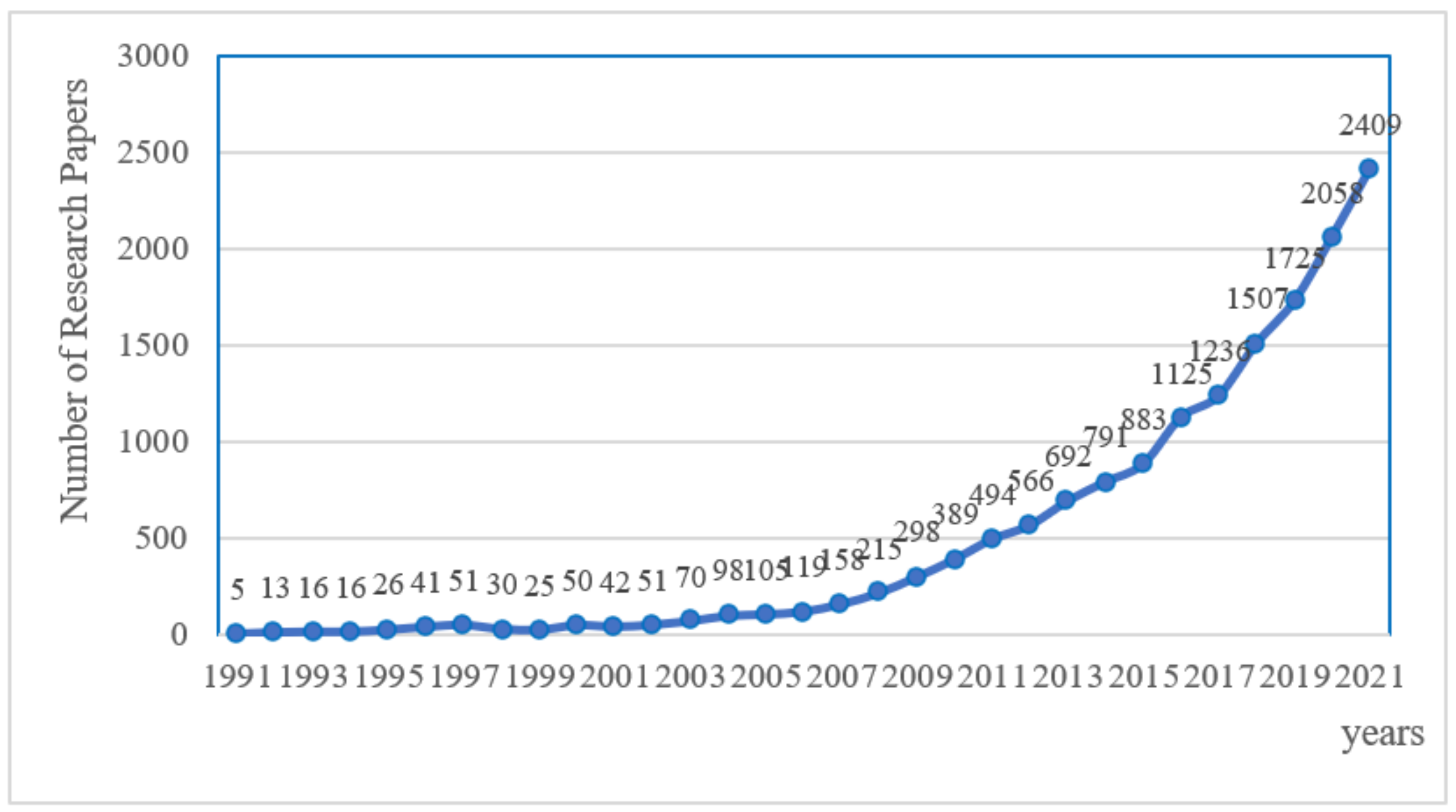
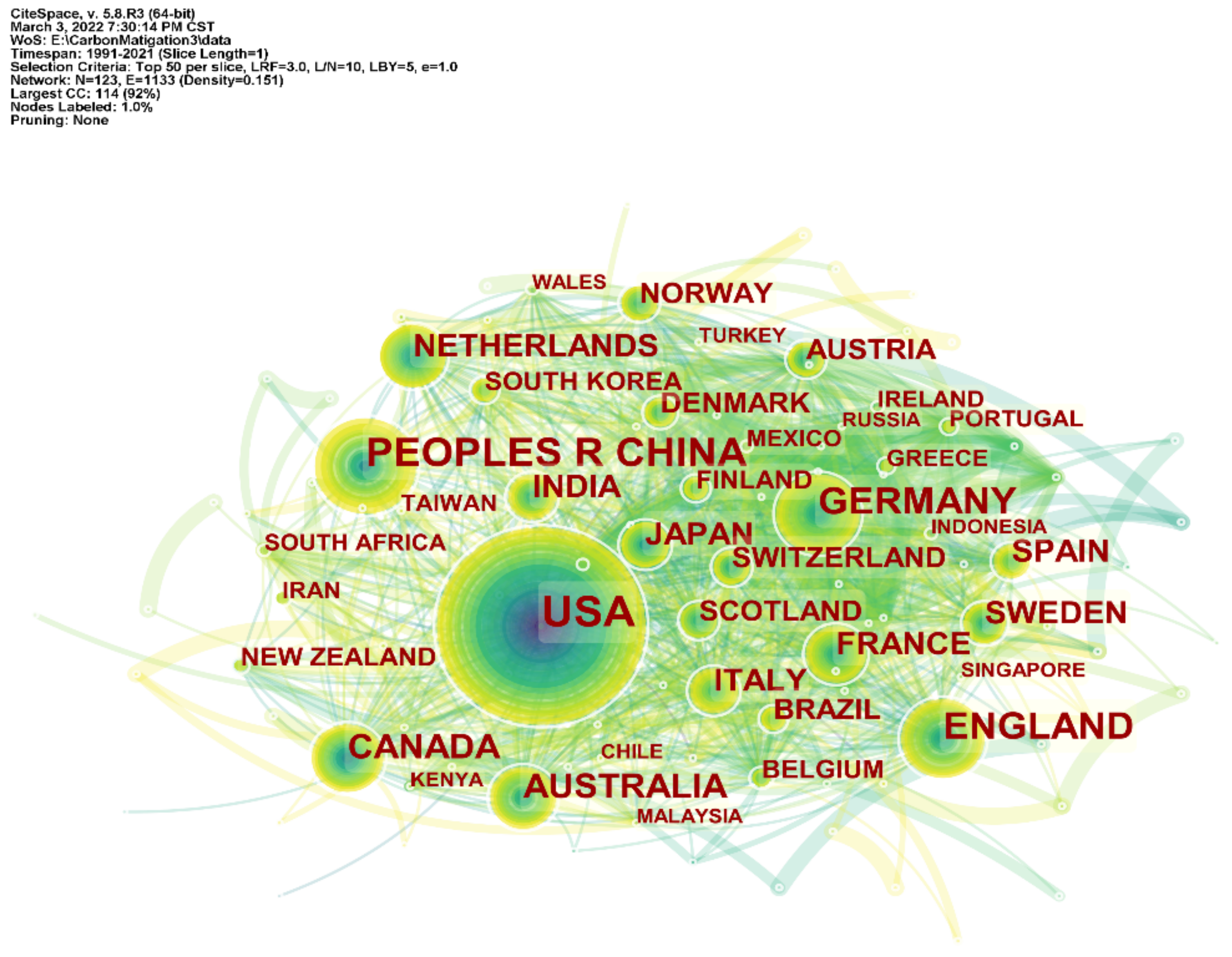
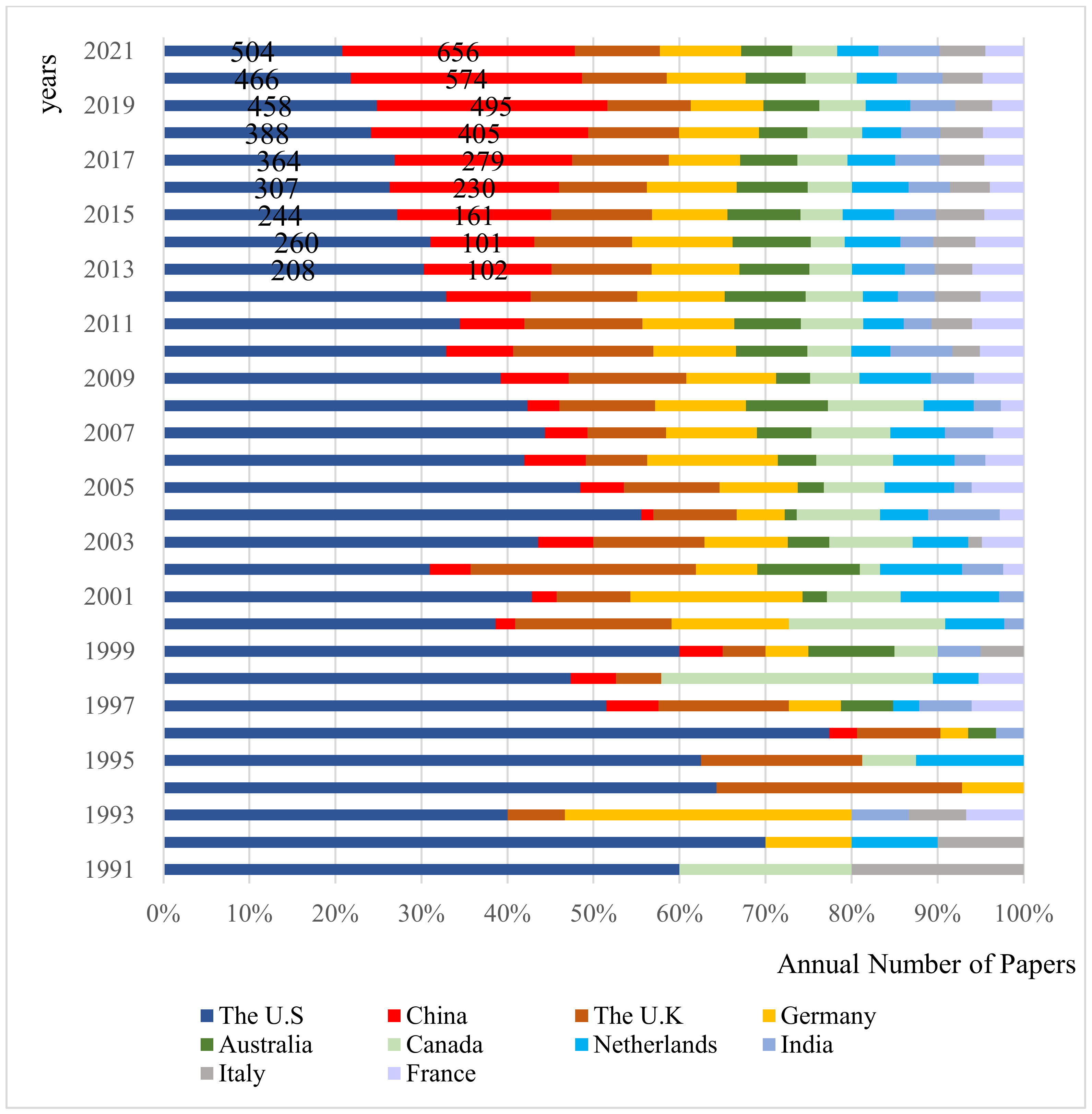
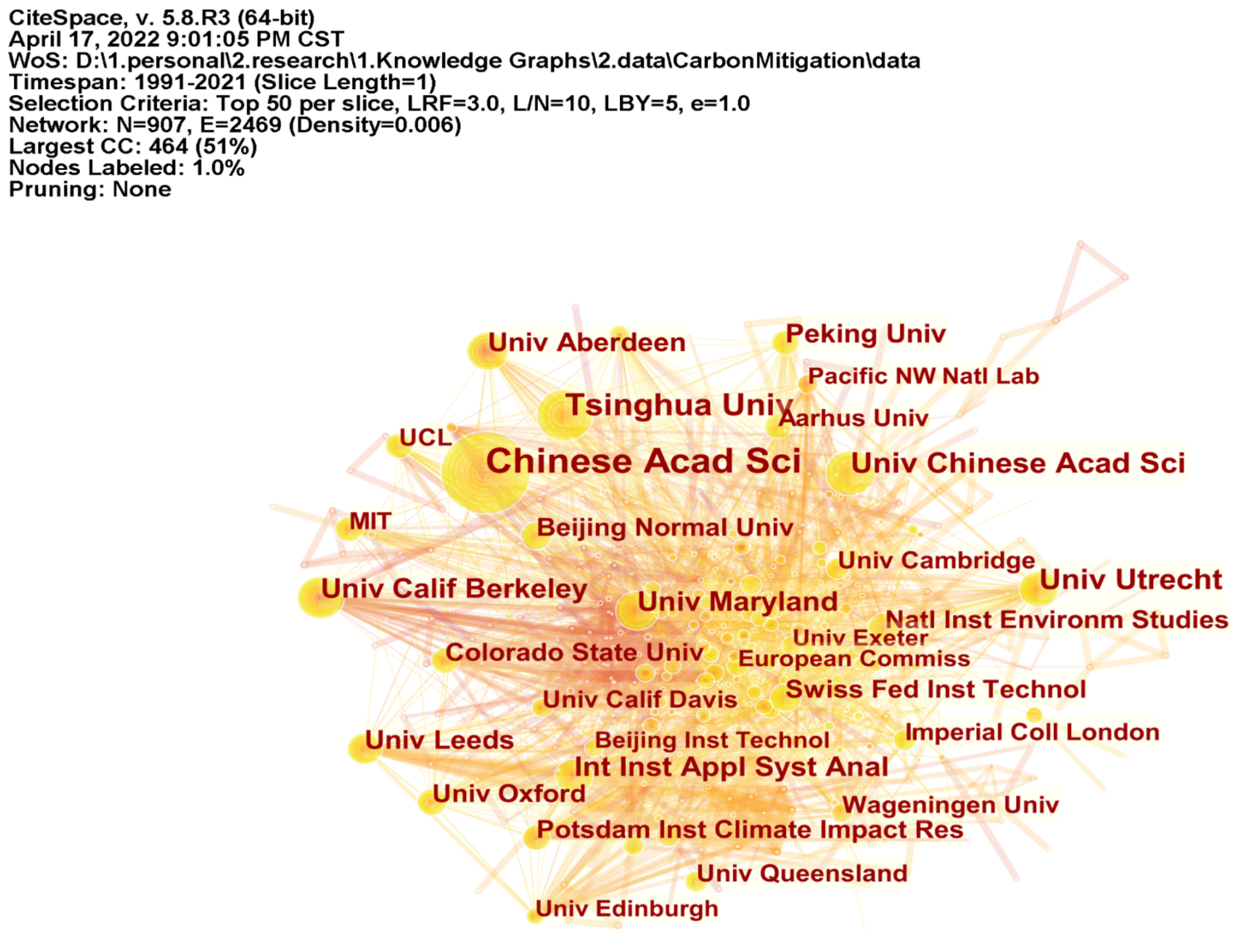

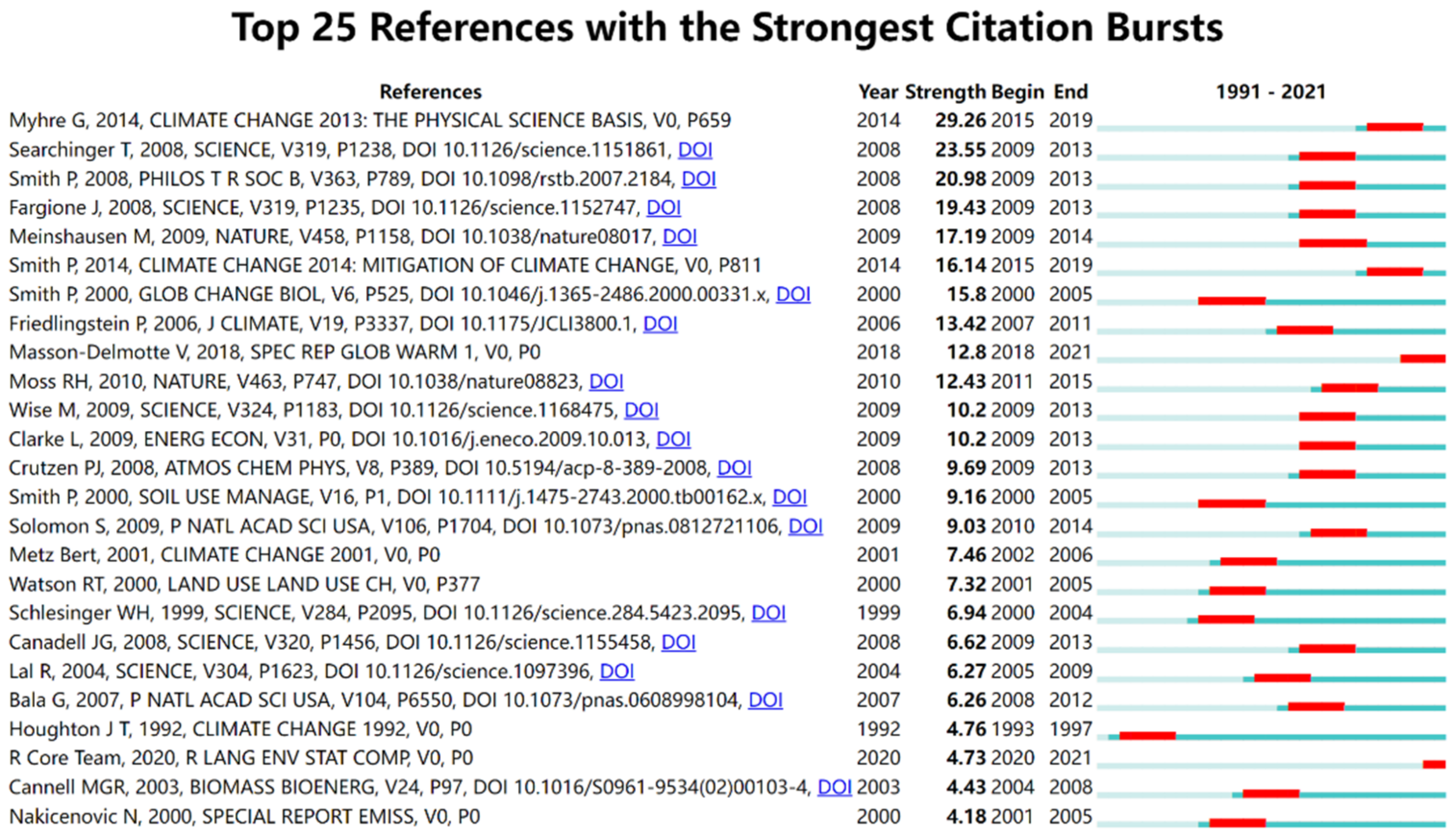
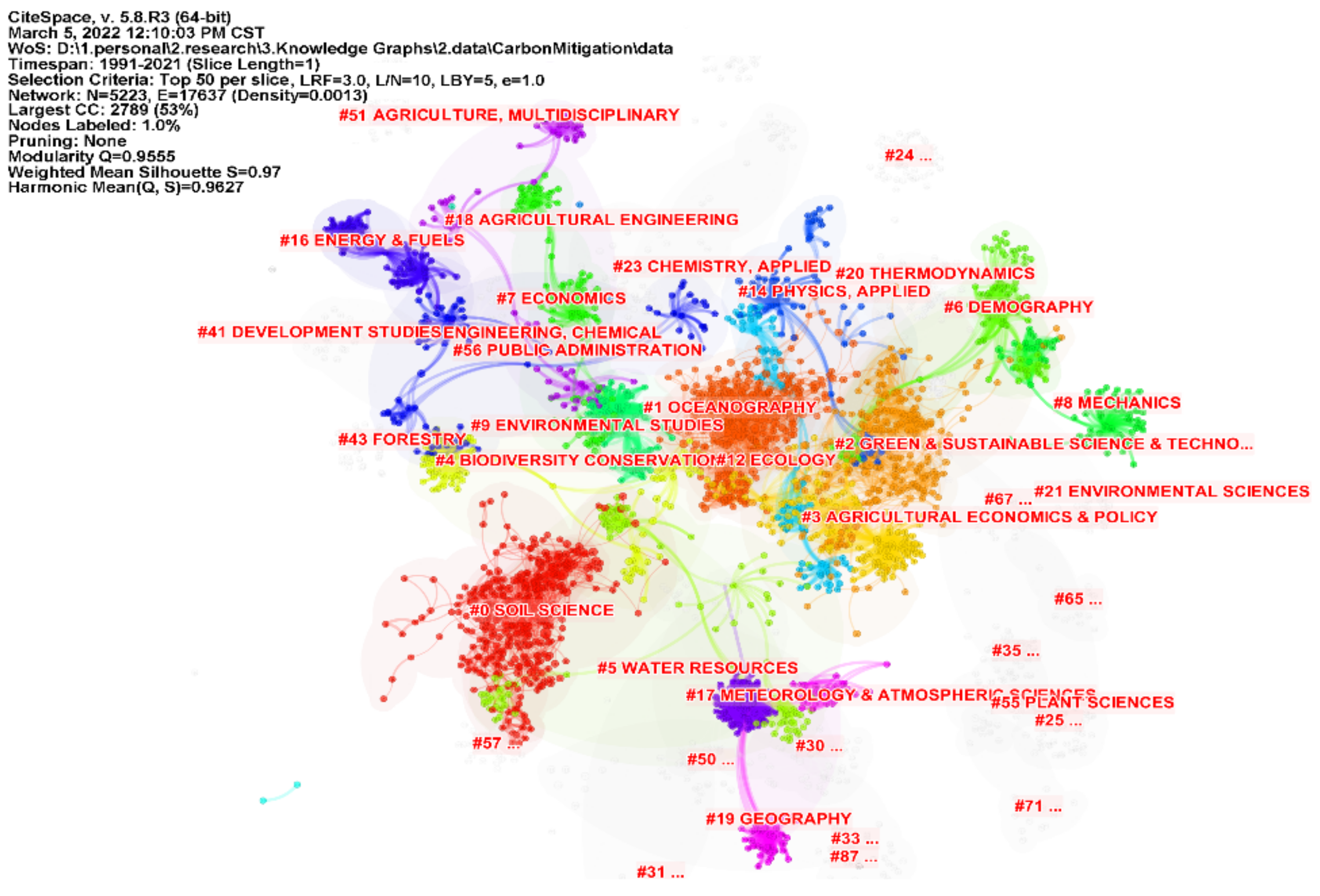
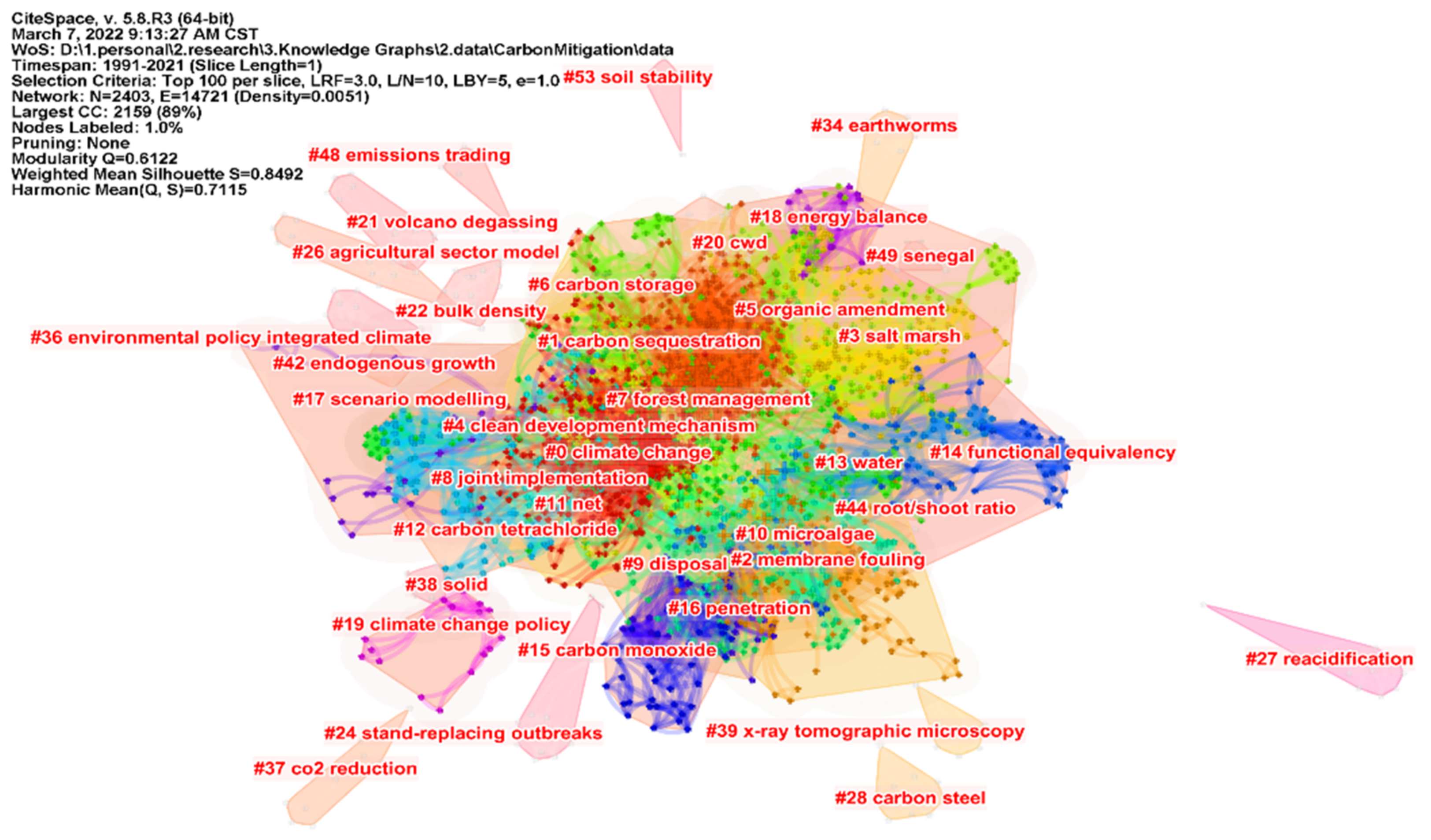
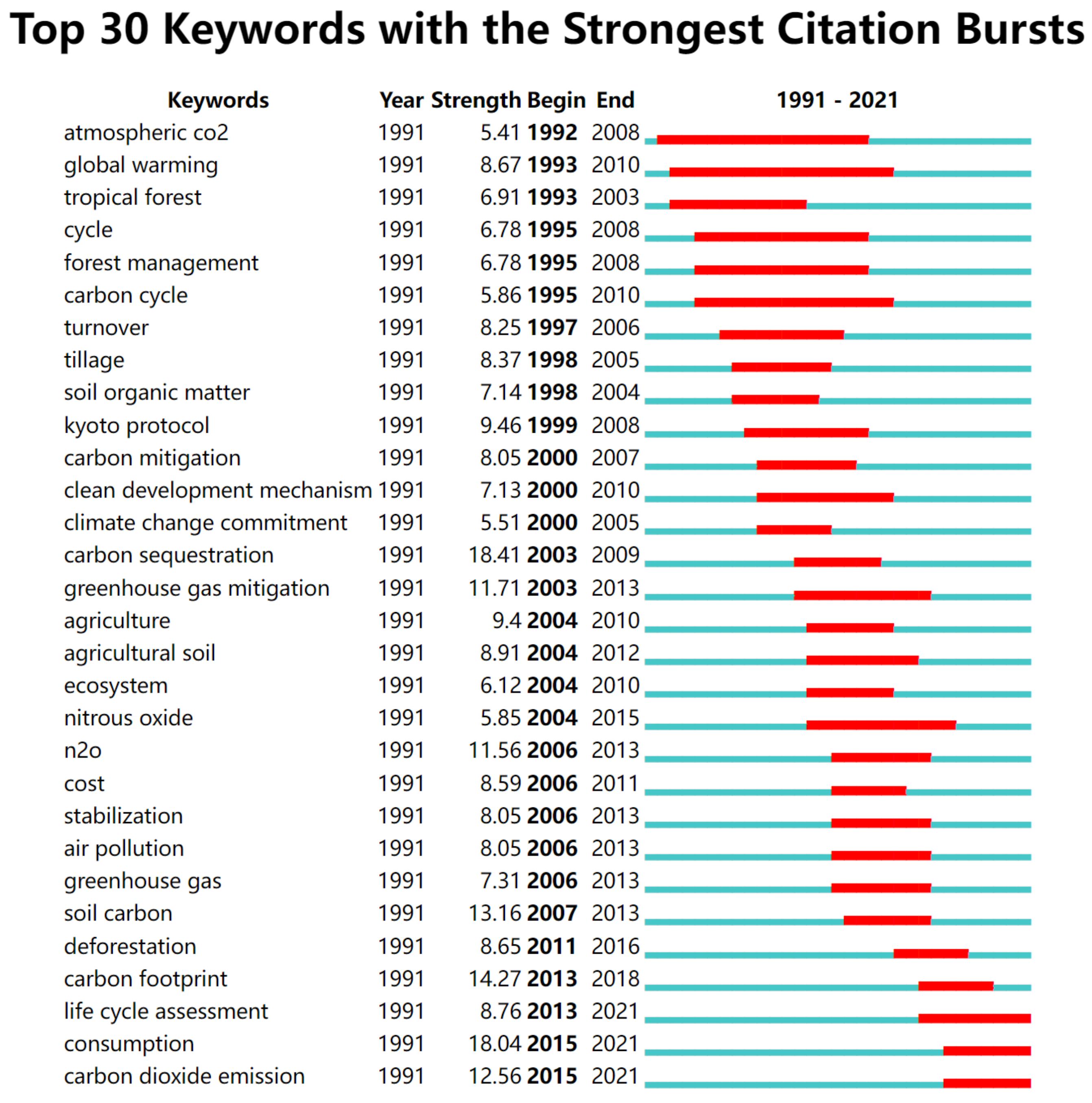
| Country | Number of Publications | Degree of Cooperative Network Intensity |
|---|---|---|
| The USA | 4213 | 132 |
| China | 3180 | 104 |
| The UK | 1686 | 125 |
| Germany | 1479 | 112 |
| Australia | 1076 | 101 |
| Canada | 896 | 93 |
| Netherlands | 828 | 97 |
| India | 795 | 93 |
| Italy | 731 | 102 |
| Research Institutions | Number of Publications | Degree of Cooperative Network Intensity | Funding Agencies | Number of Publications |
|---|---|---|---|---|
| Chinese Academy of Sciences, China | 714 | 1148 | National Natural Science Foundation of China, China | 1806 |
| University of California System, The USA | 532 | 1220 | European Commission | 843 |
| USA. Department of Energy, The USA | 521 | 1039 | UK Research and Innovation, The UK | 764 |
| Tsinghua University, China | 336 | 450 | National Science Foundation, The USA | 561 |
| USA. Department of Agriculture, The USA | 319 | 639 | Natural Environment Research Council, The UK | 405 |
| Centre National de la Recherche Scientifique, France | 306 | 1099 | United States Department of Energy, The USA | 358 |
| International Institute for Applied Systems Analysis, Austria | 304 | 661 | Fundamental Research Funds for the Central Universities, China | 264 |
| Potsdam Institute for Climate Impact Research, Germany | 261 | 465 | Engineering and Physical Sciences Research Council, The UK | 248 |
| Helmholtz Association, Germany | 253 | 773 | Conselho Nacional de Desenvolvimento Científico e Tecnológico, Brazil | 193 |
| Wageningen University & Research, Netherlands | 246 | 660 | United States Department of Agriculture, The USA | 187 |
Publisher’s Note: MDPI stays neutral with regard to jurisdictional claims in published maps and institutional affiliations. |
© 2022 by the authors. Licensee MDPI, Basel, Switzerland. This article is an open access article distributed under the terms and conditions of the Creative Commons Attribution (CC BY) license (https://creativecommons.org/licenses/by/4.0/).
Share and Cite
Su, N.; Wang, Z. Visual Analysis of Global Carbon Mitigation Research Based on Scientific Knowledge Graphs. Int. J. Environ. Res. Public Health 2022, 19, 5766. https://doi.org/10.3390/ijerph19095766
Su N, Wang Z. Visual Analysis of Global Carbon Mitigation Research Based on Scientific Knowledge Graphs. International Journal of Environmental Research and Public Health. 2022; 19(9):5766. https://doi.org/10.3390/ijerph19095766
Chicago/Turabian StyleSu, Na, and Zhenbo Wang. 2022. "Visual Analysis of Global Carbon Mitigation Research Based on Scientific Knowledge Graphs" International Journal of Environmental Research and Public Health 19, no. 9: 5766. https://doi.org/10.3390/ijerph19095766
APA StyleSu, N., & Wang, Z. (2022). Visual Analysis of Global Carbon Mitigation Research Based on Scientific Knowledge Graphs. International Journal of Environmental Research and Public Health, 19(9), 5766. https://doi.org/10.3390/ijerph19095766






